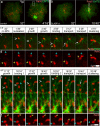Golgi-derived CLASP-dependent microtubules control Golgi organization and polarized trafficking in motile cells
- PMID: 19701196
- PMCID: PMC2748871
- DOI: 10.1038/ncb1920
Golgi-derived CLASP-dependent microtubules control Golgi organization and polarized trafficking in motile cells
Abstract
Microtubules are indispensable for Golgi complex assembly and maintenance, which are integral parts of cytoplasm organization during interphase in mammalian cells. Here, we show that two discrete microtubule subsets drive two distinct, yet simultaneous, stages of Golgi assembly. In addition to the radial centrosomal microtubule array, which positions the Golgi in the centre of the cell, we have identified a role for microtubules that form at the Golgi membranes in a manner dependent on the microtubule regulators CLASPs. These Golgi-derived microtubules draw Golgi ministacks together in tangential fashion and are crucial for establishing continuity and proper morphology of the Golgi complex. We propose that specialized functions of these two microtubule arrays arise from their specific geometries. Further, we demonstrate that directional post-Golgi trafficking and cell migration depend on Golgi-associated CLASPs, suggesting that correct organization of the Golgi complex by microtubules is essential for cell polarization and motility.
Figures








Similar articles
-
Asymmetric CLASP-dependent nucleation of noncentrosomal microtubules at the trans-Golgi network.Dev Cell. 2007 Jun;12(6):917-30. doi: 10.1016/j.devcel.2007.04.002. Dev Cell. 2007. PMID: 17543864 Free PMC article.
-
Concerted effort of centrosomal and Golgi-derived microtubules is required for proper Golgi complex assembly but not for maintenance.Mol Biol Cell. 2012 Mar;23(5):820-33. doi: 10.1091/mbc.E11-06-0550. Epub 2012 Jan 19. Mol Biol Cell. 2012. PMID: 22262454 Free PMC article.
-
Molecular Pathway of Microtubule Organization at the Golgi Apparatus.Dev Cell. 2016 Oct 10;39(1):44-60. doi: 10.1016/j.devcel.2016.08.009. Epub 2016 Sep 22. Dev Cell. 2016. PMID: 27666745
-
Regulatory mechanisms and cellular functions of non-centrosomal microtubules.J Biochem. 2017 Jul 1;162(1):1-10. doi: 10.1093/jb/mvx018. J Biochem. 2017. PMID: 28338985 Review.
-
Microtubule network asymmetry in motile cells: role of Golgi-derived array.Cell Cycle. 2009 Jul 15;8(14):2168-74. doi: 10.4161/cc.8.14.9074. Epub 2009 Jul 20. Cell Cycle. 2009. PMID: 19556895 Free PMC article. Review.
Cited by
-
Agrin regulates CLASP2-mediated capture of microtubules at the neuromuscular junction synaptic membrane.J Cell Biol. 2012 Aug 6;198(3):421-37. doi: 10.1083/jcb.201111130. Epub 2012 Jul 30. J Cell Biol. 2012. PMID: 22851317 Free PMC article.
-
Fidgetin-Like 2: A Microtubule-Based Regulator of Wound Healing.J Invest Dermatol. 2015 Sep;135(9):2309-2318. doi: 10.1038/jid.2015.94. Epub 2015 Mar 10. J Invest Dermatol. 2015. PMID: 25756798 Free PMC article.
-
Myotonic dystrophy RNA toxicity alters morphology, adhesion and migration of mouse and human astrocytes.Nat Commun. 2022 Jul 4;13(1):3841. doi: 10.1038/s41467-022-31594-9. Nat Commun. 2022. PMID: 35789154 Free PMC article.
-
The organization and function of the Golgi apparatus in dendrite development and neurological disorders.Genes Dis. 2022 Dec 20;10(6):2425-2442. doi: 10.1016/j.gendis.2022.11.009. eCollection 2023 Nov. Genes Dis. 2022. PMID: 37554209 Free PMC article. Review.
-
Golgi apparatus self-organizes into the characteristic shape via postmitotic reassembly dynamics.Proc Natl Acad Sci U S A. 2017 May 16;114(20):5177-5182. doi: 10.1073/pnas.1619264114. Epub 2017 May 1. Proc Natl Acad Sci U S A. 2017. PMID: 28461510 Free PMC article.
References
Publication types
MeSH terms
Substances
Grants and funding
LinkOut - more resources
Full Text Sources

